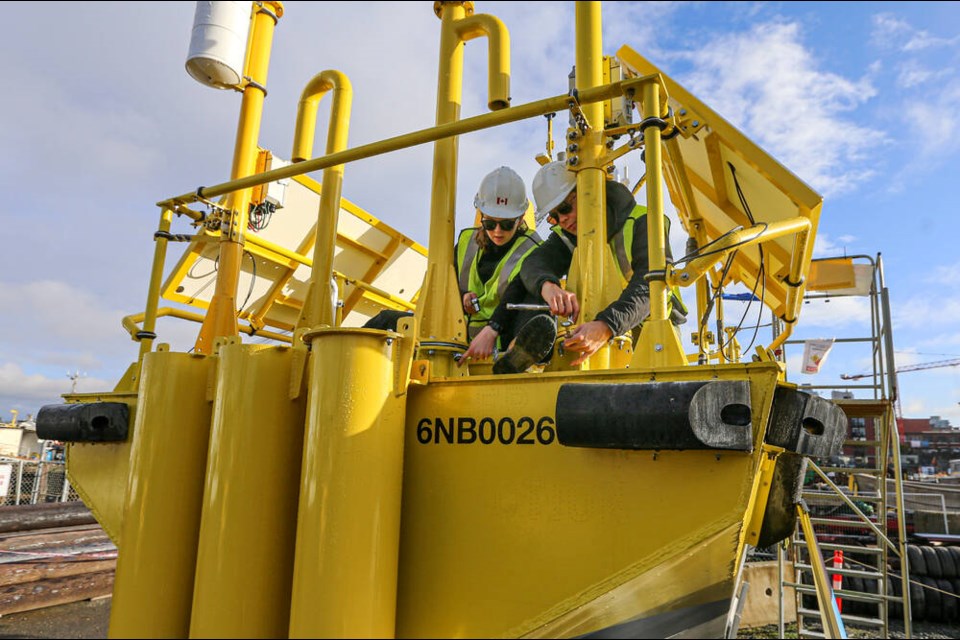Researchers at the University of Victoria unveiled a special buoy Wednesday that can help identify sites for turbines or potential wind farms that could eventually power remote communities on the coast.
The hope is that using the buoy to gather real-time, long-term wind information will help remote marinas, fishing lodges and First Nations communities harness the wind and wean themselves off diesel generators.
Off-grid or end-of-grid communities often rely on diesel fuel to supply electrical needs, said Chloe Immonen, who is part of UVic’s Pacific Regional Institute for Marine Energy Discovery research lab.
Many First Nations communities that lose power during storms have to wait long periods for power lines to be restored. “This gives some of those places an option in the future to use renewable energy if the conditions are there,” Immonen said.
The customized buoy — an impressive structure at nine metres high and 5,500 kilograms — uses vertical Light Detection and Ranging (LiDAR) technologies that measure wind speed and direction within a column that rises 200 metres above the water’s surface — the same height as a typical offshore wind turbine.
LiDAR sensors can gather wind patterns at various intervals up the 200-metre column, because winds change depending on the height above sea level.
Researchers say gathering this type of data over long periods ensures the information is recognized by International ElectroTechnical Commission standards and helps the industry determine best sites for effective offshore wind turbine projects.
This type of buoy is the first in B.C. waters, and eliminates the need to install fixed structures to do the same testing.
The bright yellow buoy will be deployed 200 metres southwest of Trial Island within weeks, depending on weather conditions. It will barged from Point Hope Maritime shipyard to the site by Salish Sea Industrial Services and anchored by 50-tonne anchor weight and heavy chains.
The buoy will remain near Trial Island off Oak Bay for about six months as researchers calibrate the equipment and gain a better understanding of the ways offshore winds can be harnessed to create sustainable energy.
The buoy will use meteorological and oceanographic sensors to continuously gather and transmit live data about wind speed and behaviour. The data is critical in helping to address a significant knowledge gap that has prevented offshore wind energy produced by floating turbines from being used more widely, said lead researcher Brad Buckham.
Buckham said although land-based wind turbines still account for a small percentage of global energy needs, they have become an increasingly popular source of renewable energy. By contrast, wind energy produced by turbines located in the ocean hasn’t been exploited to the same extent, mostly because of the lack of data needed by industry to develop accurate, certifiable, insurable technologies.
“This buoy will be in place for a sustained period as part of a data collection campaign for the purpose of trying to support a floating offshore wind industry,” says Buckham.
The research team contracted Sidney-based AXYS Technologies to build the buoy at a cost of $1.8 million.
It’s part of a larger project UVic project collecting data on wave power and receives funding from the Canadian Foundation for Innovation and the B.C. Knowledge Development Fund.
“The group has been working on this for several years, so everyone is excited to see the buoy deployed and start seeing the data,” said Immonen.
The data will be transmitted over cellular networks with satellite as a backup, and fed live to the Canadian Integrated Ocean Observing system, an open-access software platform.
AXYS Technologies spokesman Alex Velasco said the company has produced several three-metre buoys for Environment Canada that have been deployed along the west coast, but they are smaller and equipped with other specialized equipment.
This buoy is twice the size and took about six months to complete using a large part of its local workforce of about 30. The company also has operations in Europe, South America and Asia.
Velasco said the buoy will provide “flexibility” on researching sites for possible wind turbines because there isn’t a need for a fixed land mast to affix testing equipment to. “It’s easy to move around,” he said.
AXYS has built and commissioned more than 250 meteorological and oceanographic stations in 250 countries.



